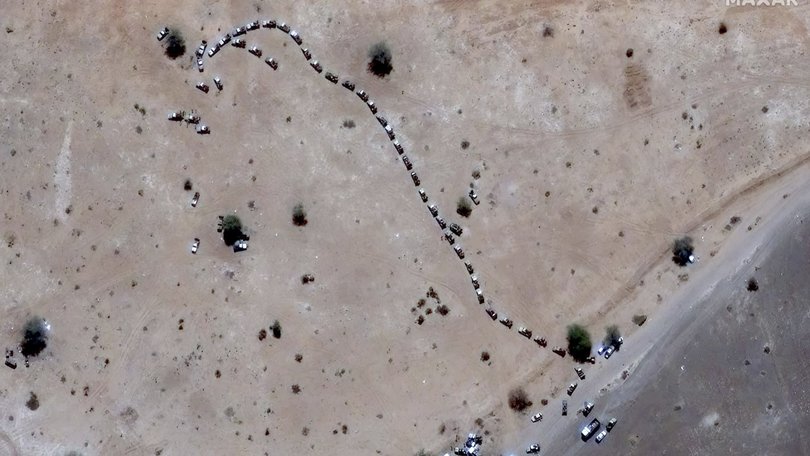THE NEW YORK TIMES: Starving children eat animal feed in besieged Sudanese city

The city’s last functioning hospital has been bombed more than 30 times. Between 30 and 40 severely malnourished children arrive every day, seeking help. There’s nothing to give them but animal feed.
“Even we’re eating animal feed,” said Dr Omar Selik, tilting his camera during a video call to show his meal: a sludgy paste made from pressed peanuts that is usually given to cows, camels and donkeys. “There’s nothing else.”
El Fasher is the worst battleground of Sudan’s brutal civil war. For nearly 18 months the city, in the western region of Darfur, has been under siege by paramilitaries trying to starve it into submission. Fighters have erected a 20-mile earthen wall around its boundaries.
Sign up to The Nightly's newsletters.
Get the first look at the digital newspaper, curated daily stories and breaking headlines delivered to your inbox.
By continuing you agree to our Terms and Privacy Policy.That leaves residents with a dire set of choices. Stay, and risk being bombed or starved. Run, and risk being killed, robbed or sexually assaulted.
“People seem to have forgotten us,” said Selik, breaking into tears as he spoke. “Oh my God, it’s a very painful story.”
The war in Sudan started more than two years ago, when clashes broke out between Sudan’s army and its paramilitary rival, the Rapid Support Forces. The fight has engulfed Africa’s third-largest country, forcing about 12 million people from their homes, killing tens of thousands and setting off a major famine. Aid groups call it the world’s biggest humanitarian crisis.
Since March, when the Rapid Support Forces was expelled from the capital, Khartoum, the group has redoubled its effort to capture Darfur, the vast region in western Sudan where most RSF fighters are from. El Fasher is the last city in their way.
Animal feed, known locally as ambaz, is a desperate solution
More than 500,000 people have fled El Fasher since April, when the RSF rampaged through Zamzam, a famine-stricken camp 7 miles south of the city, killing between 300 and 1,500 people in what the UN described as one of the worst massacres of the war.
A month later, the RSF began to circle the city with the giant earthen berm, according to satellite images published by the Yale School of Public Health. On August 27, construction to extend the berm was continuing.
An estimated 260,000 people are left in El Fasher, trapped by the tightening siege. A kilo of pasta sells for $73, 10 times the normal price, Taha Khater, one of the few aid workers left in the city, said by phone. His group, known as the Emergency Response Rooms, recorded the deaths of 14 children from malnutrition in the past two weeks. Cholera is spreading.
Food convoys from the United Nations, which has not been able to deliver food to El Fasher in over a year, have been attacked by drones as they approached the city.
One strike in June, on a convoy of 15 trucks, killed five aid workers; another last month destroyed three trucks and forced the rest to turn back. It is unclear which side carried out the attacks.
Young men attempting to flee the city, scrambling over the berm at night, have been executed by fighters, Khater said.
International aid groups offer help in Tawila, a small town 40 miles to the west now heaving with more than 600,000 refugees. But the journey to Tawila is perilous. Fighters roam the area, robbing or extorting fleeing civilians. The road is lined with hastily dug graves and abandoned bodies, aid workers say.
“They are just left there,” said Sylvain Penicaud, head of the Doctors Without Borders hospital in Tawila, by phone.
Rape is commonplace. The hospital treats about 40 sexual assault victims every week, but anecdotal evidence suggests “that is nothing compared to the true rate,” Penicaud said.
Sudan’s military has also been accused of widespread war crimes, including bombing raids on crowded markets near El Fasher that killed several hundred people. In January, the United States imposed sanctions on Gen. Abdel Fattah Burhan, the leader of Sudan’s military, for alleged use of chemical weapons.
But only the RSF has been accused of genocide, and this month UN investigators determined that the long list of atrocities committed by its troops in El Fasher amount to crimes against humanity. An RSF spokesperson did not respond to questions for this story.
Foreign involvement in the war in Sudan has worsened the siege. The United Arab Emirates has supplied guns, drones and medical support to the RSF, hoping to push the group toward victory, The New York Times has reported.
This month, Sudan’s military-led government submitted a dossier to the UN Security Council that accused the Emirates of hiring a group of Colombian mercenaries, known as the Desert Wolves, to fight alongside the RSF.
The dossier, which included passport copies, contracts and a list of 170 people said to be mercenaries, came soon after video footage and photos purporting to show Colombian fighters in central El Fasher circulated online. The Times was able to verify the location of one video, but not the identities of the fighters.
The Emirates has repeatedly denied supporting either side in Sudan’s war and dismissed the Sudanese dossier as a fabrication.
Hospitals are a major target in the conflict. Of about 200 medical facilities in El Fasher before the war, just one remains — the Al Saudi hospital, where a handful of besieged medics are hanging on, despite bombs, starvation and a vanishing supply of medicines.
Targeted more than 30 times in the war, the worst strike was in January, when an RSF drone fired a missile into a crowded ward, killing 70 patients and staff said Suleman, a senior doctor who works there.
Now, doctors shelter in foxholes during bombing raids, and malnourished patients are sustained with animal feed, said Suleman, who asked to be identified by one name because he has received death threats for his work.
The animal feed, known locally as ambaz, is a desperate solution, because it is prone to fungal contamination, especially in the rainy season. At least 18 residents have died in recent weeks after eating ambaz, local responders said.
“But there is no other option,” Suleman said.
In recent weeks, the RSF has pushed deeper into El Fasher, forcing the Sudanese military and allied ethnic militias into the city’s northwestern corner.
As they fight, RSF fighters have targeted civilians from the ethnic Zaghawa group, human rights groups say, raising fears of an ethnic massacre if they take the city outright.
Salwa Ahmed, a university lecturer, tried to stay ahead of the fighting. She fled her home as the RSF advanced, hurrying through streets littered with the bodies of fallen fighters, she said. Eventually she reached a safer place, even if bombs continued to fall nearby, she said.
But now her husband, Essam, was missing. He returned to their home a week earlier, to fetch some belongings. By Friday, he still hadn’t returned.
“We don’t know if he’s dead or alive,” she said.
As the siege has tightened, some residents have smuggled small amounts of food and medicine into the city by scrambling over the earthen berm at night. But those caught by fighters face beatings and threats.
One video that circulated recently in a Telegram channel run by RSF supporters showed a man in an RSF uniform wielding a whip over a man cowering on the ground.
Diplomatic efforts to stop the fighting have yielded few results. On August 13, the UN Security Council repeated its call for an end to the siege of El Fasher, two days after RSF fighters stormed a camp in the city, killing 57 people.
Three days later, the RSF stormed into the camp again, this time killing 32 people, Human Rights Watch reported.
This article originally appeared in The New York Times.
© 2025 The New York Times Company
Originally published on The New York Times
